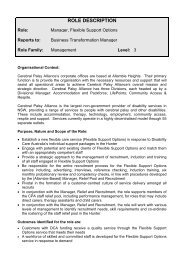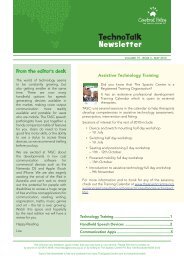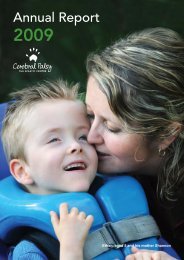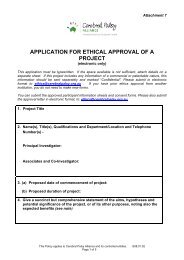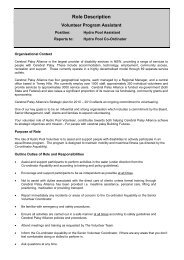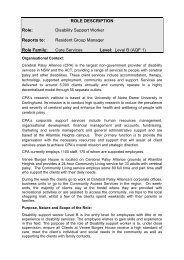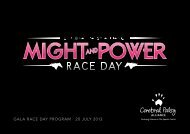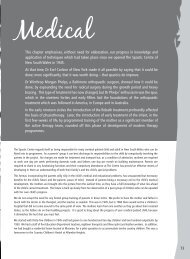TECHNOTALKVOLUME 20 - ISSUE 1 - APRIL 2011ASSESSMENT CONSIDERATIONSAssessing a client’s ability to use eye tracking as an access method can be difficult, especially for a therapist who has limitedexperience in using an eye tracking system and/or limited experience in working with speech generating devices. There are manyconsiderations including clinical and technical issues that must be addressed in order to ensure that a valid and reliable assessmentof the client is able to be completed.For general information and assistance on the process to follow when completing an eye tracking assessment, please see the webbasedresource from the COGAIN website: http://www.cogain.org/w/images/5/5a/Assessment.pdfTASC can provide a handout to support therapists should some specific information on step-by-step considerations for what toconsider in an eye tracking assessment be required. A thorough eye tracking assessment is essential when applying for funding asclear assessment and clinical reasoning will be required in order for an eye tracking system to be funded.WHAT IS ACCURACY WHEN TALKING ABOUT EYE TRACKING?Generally, accuracy refers to the ability of the system to know where the eyes are actually looking. Accuracy of eyetracking may be affected by the quality of calibration, vision issues, eye variations, background/ambient lighting (especiallyincandescent bulbs and sunlight), head movement, the quality of the eye tracking system, and many other factors.The accuracy of a system when used by each client should be investigated and tested by the therapist during assessmentand trial of eye tracking systems. It should be noted that there are ways of compensating for poor accuracy onmost systems, so contact a specialist technology service or the supplier of the system. Also refer to the resources at:http://www.cogain.org/wiki/User_Involvement_Exemplars_GridsBACK-UP ACCESSAs with most technology, eye tracking is not completely reliable as an access method and there are environmental factors (especiallysunlight), and technological difficulties (software and hardware failure) that will mean that the user may not always be able toaccess their device or computer using their eye tracking system. TASC recommends that a back-up low-tech option is availablewhen eye tracking is used for the person to access communication and that an alternative computer access method is available forthose who use eye tracking to access a computer.LEARNING HOW TO USE EYE TRACKINGSome users of eye tracking systems who have no difficulties with calibration, cognitive abilities within normal limits and who canfollow complex instructions are able to learn to use eye tracking for basic access to a communication grid within a single therapysession, however for clients who have limited attention span, complex issues with their eyes, difficulty following instructions, and/or cognitive impairment, they may take much longer to learn how to use eye tracking or they may have difficulty learning to useeye tracking as a functional access method.This process of teaching a client how to use eye tracking may not be possible in trial circumstances as it may require the availabilityof an eye tracking system over a long period of time and the regular involvement of a therapist with experience in the teaching ofthe skill of eye tracking. Loans of eye tracking systems are usually limited to two or four weeks and for some users, this may not besufficient time to establish whether they have the capacity to use a system functionally.There is currently no research available regarding the age or level of cognition required to be able to functionally access eyetracking, however, TASC has experience in implementing eye tracking systems with clients as young as three years old who havebeen assessed as having a cognitive ability in the normal range.Once the functional skills and prerequisites for eye tracking have been established and clear goals have been set, the followingtable(s) can be used as a resource to match your client and their needs to the most suitable device. If you require support in thisfeature-matching process, it is recommended to consult with a specialist assistive technology service. Suppliers of eye trackingsystems may also be able to assist.CEREBRALPALSY.ORG.AU4
TECHNOTALKVOLUME 20 - ISSUE 1 - APRIL 2011HOW DOES IT WORK?The most common techniques used to track eye movements are called Pupil Centre Corneal Reflection (PCCR) or dark pupilinfrared illumination. These techniques are non-intrusive and both options use a light source to illuminate the eye enabling aspecial camera to track the movements and positions of the eye. The illumination is near infrared and therefore unnoticeableto the user but creates patterns on the cornea and/or pupil of the eye that can be tracked by image sensors that are usedto capture images of the eyes and the infrared patterns. A computer then uses advanced image processing algorithmsand a physiological 3D model of the eye to calculate the position of the eye in space and then estimate the point of gaze.Adapted From www.userfirst.comMOUNTING AND POSITIONINGMounting of any device is important, but for eye tracking, it is essential. In order to maintainaccuracy of a system, it needs to be held still.In order to enable a user to access all eye tracking systems that are currently available, the screenof the system needs to be parallel to the plane of the user’s face and at eye level. Furthermore, thesystem needs to be generally 50-60cm from the user’s face. For clients who are able to sit uprightand can access a desk, this means that mounting is fairly straightforward as the system can be setup on a desk stand or desk clamp mounting arm.For clients who need their eye tracking system to be portable, there are a number of significantchallenges for mounting. Firstly, the weight and required positioning of the device means that eyetracking systems CANNOT be mounted on paediatric manual wheelchairs, strollers or any form ofwalking or standing frame. Care should be taken and stability testing should be carried out whenattaching eye tracking systems to adult manual wheelchairs and paediatric powered wheelchairsas there is a chance that the weight and position of the device when mounted to the chair couldcompromise the balance and structure of the wheelchair. Careful attention needs to be paid toweight limits of the wheelchair also.Even when the device can be securely attached to a wheelchair, the stability is tested and the clientis able to use the device when it is attached to the wheelchair, careful monitoring needs to becarried out on the mounting as significant strain can be placed on the mounting system over time.TASC has known of several bolts in eye tracking mounting systems that have needed to be replacedafter a few months of use as they were at risk of failing.For clients who want or need to access eye tracking in bed, when reclined or in a tilt-in-space posture, positioning a device canbe difficult (diagrams from ECOPoint Manual). For example, if a user is lying in bed, then the device needs to be mounted directlyabove their head and (depending on the device) 40cm-60cm away from their face with the device tilted so that the screen facesdirectly down. This position may not be able to be achieved with desk mounts or standard rolling or over-bed mounts.SUMMARYDue to the complexity of eye tracking systems and the considerations around calibration, mounting/positioning, portability,language system, accuracy, lighting issues, selection methods, and user skill, it recommended that assessment and trial of anyeye tracking system is completed with the support of a person who is experienced in dealing with such a system. TASC canprovide support to therapists in NSW and ACT who are interested in looking at eye tracking with their clients either remotely andconsultatively or through specialist assessment.CEREBRALPALSY.ORG.AU5



